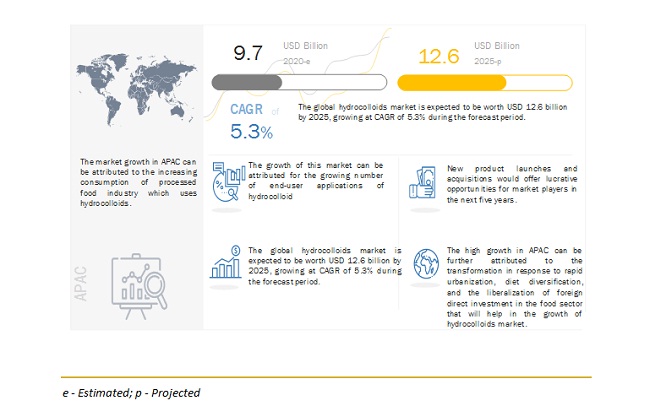The report “Hydrocolloids Market by Type (Gelatin, Xanthan Gum, Carrageenan, Alginate, Agar, Pectin, Guar Gum, Gum Arabic, MCC, and CMC), Source (Botanical, Microbial, Animal, Seaweed, and Synthetic), Function, Application, and Region – Global Forecast to 2025″, The hydrocolloids market is estimated to be valued at USD 9.7 billion in 2020 and is projected to reach USD 12.6 billion by 2025, at a CAGR of 5.3%. The growth of the hydrocolloids market is driven by the rising demand for convenience foods in the food industry.
Download PDF brochure: https://www.marketsandmarkets.com/pdfdownloadNew.asp?id=1231

The gelatin segment is estimated to be the largest
The hydrocolloids market, by type, is estimated to be dominated by the gelatin segment. The usage of gelatin as a gelling agent is projected to grow due to the increasing need for emulsifiers in the food & beverage industry in major markets such as Germany, the UK, and France. It is commonly used in candies, desserts, marshmallows, and ice creams. Gelatin functions as a texturant, gelling agent; it releases flavor and imparts proper mouthfeel to food products.
The animal-derived segment is projected to dominate the market by 2025
The hydrocolloids market, by source, is projected to be dominated by the animal-derived segment during the forecast period. Its main food application is in the confectionery sector. Due to its non-compliance with vegetarian diets, it is not accepted in several countries. The most prominent function of gelatin is gelling. It is used in an array of food products. The ancillary functions performed by gelatin are stabilizing, thickening, clarifying juices, and rendering mouthfeel to fat-reduced food.
The stabilizers segment is projected to be the fastest-growing segment during the forecast period
The stabilizers segment is projected to be the fastest-growing, by function, during the forecast period Hydrocolloids act as stabilizers in dairy products, beverages, and desserts. Food stabilizers are substances that maintain the emulsified state. They have many functions in food applications such as stabilizing, adsorbing oil droplets, increasing the viscosity of the water phase in the emulsion. Thus, they prevent the coalescence of oil droplets, which would promote the separation of the oil phase from the aqueous phase. Thus, these factors are expected to drive the growth of the segment at a significant rate during the forecast period.
Speak to Analyst: https://www.marketsandmarkets.com/speaktoanalystNew.asp?id=1231
The North America is projected to account for the largest market share during the forecast period
North America is a dominant region in the global hydrocolloids market. Factors influencing its market dominance include the high demand for functional dairy products, convenience foods, higher per capita consumption of baked goods, and presence of major players. Consumers in the US are calorie-conscious due to which low-calorie and low-fat foods are popular in the country. The increasing prevalence of obesity and cardiac diseases has led consumers to demand natural and low-calorie food products. Food manufacturers are therefore concentrating on the application of natural hydrocolloids and their function as fat replacers
This report includes a study of the marketing and development strategies used, along with the product portfolios of leading companies. It consists of the profiles of leading manufacturers such as DowDupont (US), Ingredion (US), Cargill (US), Kerry (Ireland), Archer Daniels Midland Company (US), Palsgaard (Denmark), Darling Ingredients (US), CP Kelco (US), Ashland (US), BASF (Germany), Tate & Lyle (UK), Glanbia (Ireland), Fuerst Day Lawson (UK), Koninklijke DSM N.V (Netherlands), and Nexira (France) are the players that hold a significant share in the hydrocolloids market.
